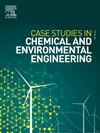Evaluation and comparison of drying models in open sun drying and photovoltaic and LPG burner assisted hybrid solar drying system
Q1 Environmental Science
Case Studies in Chemical and Environmental Engineering
Pub Date : 2025-01-19
DOI:10.1016/j.cscee.2025.101104
引用次数: 0
Abstract
This study evaluates the drying performance of open sun drying (OSD) and photovoltaic and LPG burner assisted hybrid solar drying system (HSD) systems for cocoa beans. OSD, a traditional and cost-effective method, faces limitations such as extended drying times, susceptibility to environmental contamination, and inconsistent quality. In contrast, HSD integrates solar energy with auxiliary heat sources, providing controlled drying conditions and improved efficiency. The research involved experimental comparisons between the two methods, using cocoa beans as the primary material. Measurements included temperature, relative humidity, drying duration, and energy utilization. Data were analyzed with thin-layer drying models, with the Midili model being the most accurate (R2 > 0.98). Drying trials were conducted at 40 °C, 45 °C, and 50 °C, with the target moisture content set at 7–8%. Results showed that HSD achieved superior performance, reducing drying times to 3–4 hours compared to 23 hours for OSD. HSD also demonstrated higher exergy efficiencies (94.6614 %) and lower exergy loss (0.0062 kJ/s). Furthermore, the controlled environment minimized contamination risks and preserved the quality of the cocoa beans. This study concludes that HSD significantly enhances drying efficiency, product quality, and sustainability compared to OSD. These findings suggest that hybrid drying technologies hold great potential for modernizing agricultural drying practices while addressing energy and environmental challenges.

开放式太阳干燥和光伏与LPG燃烧器辅助混合太阳能干燥系统干燥模式的评价与比较
本研究评估了开放式太阳干燥(OSD)和光伏和LPG燃烧器辅助混合太阳能干燥系统(HSD)系统对可可豆的干燥性能。OSD是一种传统的、具有成本效益的方法,但它面临着干燥时间长、易受环境污染、质量不稳定等限制。相比之下,HSD将太阳能与辅助热源相结合,提供可控的干燥条件,提高了效率。该研究以可可豆为主要原料,对这两种方法进行了实验比较。测量包括温度、相对湿度、干燥时间和能量利用率。采用薄层干燥模型对数据进行分析,其中米力模型最准确(R2 >;0.98)。在40°C、45°C和50°C条件下进行干燥试验,目标含水率设定为7-8%。结果表明,HSD取得了优异的性能,将干燥时间从OSD的23小时缩短到3-4小时。HSD还显示出更高的火用效率(94.6614%)和更低的火用损失(0.0062 kJ/s)。此外,受控环境最大限度地降低了污染风险,并保持了可可豆的质量。本研究得出结论,与OSD相比,HSD显著提高了干燥效率、产品质量和可持续性。这些发现表明,混合干燥技术在解决能源和环境挑战的同时,在农业干燥实践的现代化方面具有巨大的潜力。
本文章由计算机程序翻译,如有差异,请以英文原文为准。
求助全文
约1分钟内获得全文
求助全文
来源期刊

Case Studies in Chemical and Environmental Engineering
Engineering-Engineering (miscellaneous)
CiteScore
9.20
自引率
0.00%
发文量
103
审稿时长
40 days
 求助内容:
求助内容: 应助结果提醒方式:
应助结果提醒方式:


